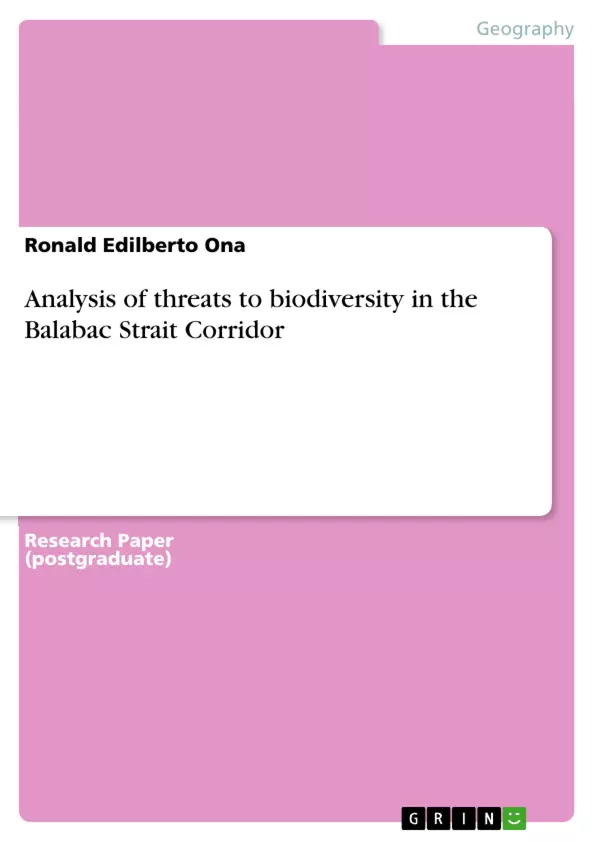The current state of the coastal environment in the Balabac Strait Corridor is exemplified by unsustainable resource management. This is indicated by numerous threats, both from anthropogenic and natural sources. For example: illegal fishing activities, coral reef destruction, illegal logging, lack of livelihood opportunities, deforestation/loss of forests, mangrove debarking, mangrove cutting on a commercial scale, wildlife poaching, loss of wildlife and illegal drugs.
While there is a widespread recognition that the biological resources are dwindling as target species for exploitation, decrease in quality, economic utilization and their consequential damages on terrestrial and marine ecosystems remain unabated. A more effective local government mechanism is needed to provide the necessary controls through appropriate local policies to address these concerns. There is a need for a concerted effort among stakeholder groups and for a harmonious approach towards resource conservation. Although attempts were made to mitigate further resource degradation, many of them did not effectively address the concerned issues. The current situation in Balabac requires external assistance (national bodies and international community), both human and material, as the local government alone cannot effectively address the tide of environmental degradation and the decline of natural resources.
Inhaltsverzeichnis (Table of Contents)
- Chapter 1 Introduction
- 1.1 Background
- 1.2 Rationale
- 1.3 Objectives
- Chapter 2 Review of Literature
- 2.1 Threat and Conservation
- 2.2 Trends in the Study of Threat
- 2.3 Types of Biodiversity Threat
- 2.3.1 Threats to Species
- 2.3.2 Threat to Habitat and Ecosystem
- 2.3.3 Threat to MPA/Corridor
- 2.4 A Model for Biodiversity Threat Propagation
- Chapter 3 Methodology
- 3.1 Method Outline
- 3.1.1 Step 1 Threats Inventory
- 3.1.2 Step 2 Threats Framework Development
- 3.1.3 Step 3 Threats Characterization Scheme
- 3.1.4 Step 4 Threats Analysis
- 3.1.5 Step 5 Modeling and Economic Valuation of Selected Threats
- 3.1.6 Step 6 Recommendations of Mitigating and Counter Measures
- Chapter 4 Results and Discussion
- 4.1 Geological and Physical Threats
- 4.1.1 A. Natural
- 4.1.1.1 Situation and Sedimentation
- 4.1.1.2 Flooding and Coastal Erosion
- 4.1.1.3 Earthquake
- 4.1.2 B. Human-induced
- 4.1.2.1 Mining
- 4.1.2.2 Groundwater Contamination
- 4.2 Biophysical Threats
- 4.3 Socio-economic Threats
- 4.3.1 Socio-economic Analysis of the Balabac Society
- 4.3.2 Social Organization
- 4.3.3 Social Stratification
- 4.3.4 Sociology of Economic Life
- 4.3.5 Socio-economic Analysis of Threats to Biodiversity
- 4.3.6 Illegal Fishing Activities
- 4.3.7 Illegal Logging
- 4.3.8 Poverty and Lack of Livelihood Opportunity
- 4.4 Political and Institutional Threat
- 4.4.1 The Political Threats Analysis
- 4.4.1.1 Party Politics
- 4.4.1.2 Political Exercise: The May 2007 Local Election
- 4.4.2 The Institutional Threats Analysis
- 4.4.2.1 The Local Government and its Policies on Environment and Expenditure
- 4.4.2.2 The Provincial Government and the Palawan Council For Sustainable Development (PSCD)
- 4.4.2.3 The Central Government and its Foreign Policy
- 4.4.2.4 Supporting Institutions
- Biodiversity threats from both anthropogenic and natural sources
- The impact of unsustainable resource management practices
- The role of local government and institutional frameworks in conservation efforts
- The need for collaborative approaches involving stakeholders and external assistance
- The socio-economic factors influencing biodiversity threats
Zielsetzung und Themenschwerpunkte (Objectives and Key Themes)
The report aims to analyze the current state of biodiversity in the Balabac Strait Corridor and identify the key threats impacting its sustainability. The study emphasizes the critical need for effective local governance, stakeholder collaboration, and external assistance to address the complex challenges faced by the region's ecosystem.
Zusammenfassung der Kapitel (Chapter Summaries)
The initial chapters provide a background and review of literature on biodiversity threats, with a focus on their various types and how they propagate within ecosystems. Chapter 3 delves into the methodology used for analyzing threats, outlining the steps involved, including threats inventory, framework development, and characterization. Chapter 4 presents the results and discussion, examining geological and physical threats, both natural and human-induced, as well as biophysical and socio-economic threats. The analysis also covers the political and institutional factors influencing the situation.
Schlüsselwörter (Keywords)
This report focuses on biodiversity threats, sustainable resource management, local governance, stakeholder collaboration, socio-economic factors, Balabac Strait Corridor, environmental degradation, and conservation efforts.
- Quote paper
- Ronald Edilberto Ona (Author), 2007, Analysis of threats to biodiversity in the Balabac Strait Corridor, Munich, GRIN Verlag, https://www.grin.com/document/1312937



